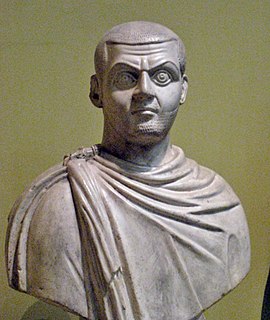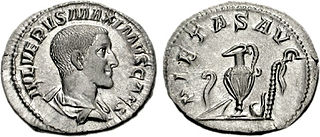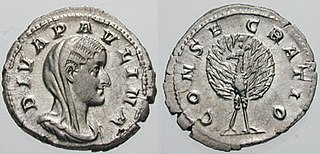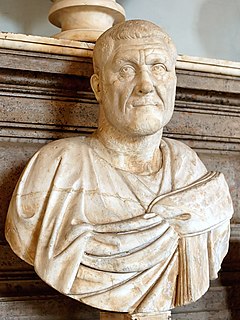Lucius Domitius Gallicanus Papinianus was a Roman senator who lived during the 3rd century CE. He was suffect consul before the year 238. [1] His murder of two soldiers of the Praetorian Guard, assisted by Macenus in March 238, triggered the revolt that brought down the Emperor Maximinus Thrax. [2]

The Roman Empire was the post-Roman Republic period of the ancient Roman civilization. Ruled by emperors, it had large territorial holdings around the Mediterranean Sea in Europe, North Africa, the Middle East, and the Caucasus. From the constitutional reforms of Augustus to the military anarchy of the third century, the Empire was a principate ruled from Italy, homeland of the Romans and metropole of the empire, with the city of Rome as capital. The Roman Empire was then ruled by multiple emperors and divided in a Western Roman Empire, based in Milan and later Ravenna, and an Eastern Roman Empire, based in Nicomedia and later Constantinople. Rome remained the nominal capital of both parts until 476 AD, when Odoacer deposed Romulus Augustus after capturing Ravenna and the Senate of Rome sent the imperial regalia to Constantinople. The fall of the Western Roman Empire to barbarian kings, along with the hellenization of the Eastern Roman Empire into the Byzantine Empire, is conventionally used to mark the end of Ancient Rome and the beginning of the Middle Ages.

A consul held the highest elected political office of the Roman Republic, and ancient Romans considered the consulship the highest level of the cursus honorum.

The Praetorian Guard was an elite unit of the Imperial Roman army whose members served as personal bodyguards to the Roman emperors. During the era of the Roman Republic, the Praetorians served as a small escort force for high-ranking officials such as senators or provincial governors like procurators, and also serving as bodyguards for high ranking officers within the Roman legions. With the republic's transition into the Roman Empire, however, the first emperor, Augustus, founded the Guard as his personal security detail. Although they continued to serve in this capacity for roughly three centuries, the Guard became notable for its intrigue and interference in Roman politics, to the point of overthrowing emperors and proclaiming their successors. In 312, the Guard was disbanded by Constantine the Great.
Details of his senatorial career have been recorded in an inscription found at Tarragona. He was governor of Dalmatia, Hispania Tarraconensis and Germania Inferior. [3]

Tarragona is a port city located in northeast Spain on the Costa Daurada by the Mediterranean Sea. Founded before the 5th century BC, it is the capital of the Province of Tarragona, and part of Tarragonès and Catalonia. Geographically, it is bordered on the north by the Province of Barcelona and the Province of Lleida. The city has a population of 201,199 (2014).

Dalmatia is one of the four historical regions of Croatia, alongside Croatia proper, Slavonia, and Istria.

Hispania Tarraconensis was one of three Roman provinces in Hispania. It encompassed much of the Mediterranean coast of modern Spain along with the central plateau. Southern Spain, the region now called Andalusia, was the province of Hispania Baetica. On the Atlantic west lay the province of Lusitania, partially coincident with modern-day Portugal.









